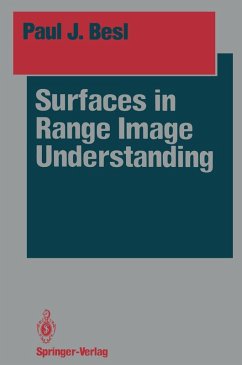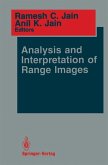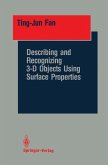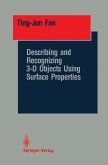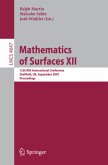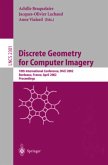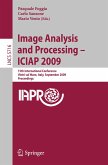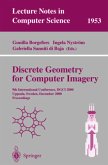Paul J. Besl
Surfaces in Range Image Understanding
Paul J. Besl
Surfaces in Range Image Understanding
- Broschiertes Buch
- Merkliste
- Auf die Merkliste
- Bewerten Bewerten
- Teilen
- Produkt teilen
- Produkterinnerung
- Produkterinnerung
Machine perception requires the digitization of physically-sensed signals. During the last ten years, digital range images have become available from a variety of sensors. This book is devoted to the problem of range image understanding with computers. Its aims are to develop a theoretical framework, devise appropriate algorithms, and demonstrate a software implementation of those algorithms that will confirm the usefulness of surfaces in range image understanding. It will be of interest to the researcher studying the theoretical concepts of image understanding, as well as the engineer who wants to implement these concepts in practical applications.…mehr
Andere Kunden interessierten sich auch für
![Analysis and Interpretation of Range Images Analysis and Interpretation of Range Images]() Analysis and Interpretation of Range Images77,99 €
Analysis and Interpretation of Range Images77,99 €![Describing and Recognizing 3-D Objects Using Surface Properties Describing and Recognizing 3-D Objects Using Surface Properties]() Ting-Jun FanDescribing and Recognizing 3-D Objects Using Surface Properties77,99 €
Ting-Jun FanDescribing and Recognizing 3-D Objects Using Surface Properties77,99 €![Describing and Recognizing 3-D Objects Using Surface Properties Describing and Recognizing 3-D Objects Using Surface Properties]() Ting-Jun FanDescribing and Recognizing 3-D Objects Using Surface Properties77,99 €
Ting-Jun FanDescribing and Recognizing 3-D Objects Using Surface Properties77,99 €![Mathematics of Surfaces XII Mathematics of Surfaces XII]() Ralph Martin / Malcolm Sabin / Joab Winkler (eds.)Mathematics of Surfaces XII38,99 €
Ralph Martin / Malcolm Sabin / Joab Winkler (eds.)Mathematics of Surfaces XII38,99 €![Discrete Geometry for Computer Imagery Discrete Geometry for Computer Imagery]() Achille Braquelaire / Jacques-Olivier Lauchaud / Anne Vialard (eds.)Discrete Geometry for Computer Imagery39,99 €
Achille Braquelaire / Jacques-Olivier Lauchaud / Anne Vialard (eds.)Discrete Geometry for Computer Imagery39,99 €![Image Analysis and Processing -- ICIAP 2009 Image Analysis and Processing -- ICIAP 2009]() Image Analysis and Processing -- ICIAP 2009113,99 €
Image Analysis and Processing -- ICIAP 2009113,99 €![Discrete Geometry for Computer Imagery Discrete Geometry for Computer Imagery]() Gunilla Borgefors / Ingela Nyström / Gabriella Sanniti di Baja (eds.)Discrete Geometry for Computer Imagery77,99 €
Gunilla Borgefors / Ingela Nyström / Gabriella Sanniti di Baja (eds.)Discrete Geometry for Computer Imagery77,99 €-
-
-
Machine perception requires the digitization of physically-sensed signals. During the last ten years, digital range images have become available from a variety of sensors. This book is devoted to the problem of range image understanding with computers. Its aims are to develop a theoretical framework, devise appropriate algorithms, and demonstrate a software implementation of those algorithms that will confirm the usefulness of surfaces in range image understanding. It will be of interest to the researcher studying the theoretical concepts of image understanding, as well as the engineer who wants to implement these concepts in practical applications.
Produktdetails
- Produktdetails
- Springer Series in Perception Engineering
- Verlag: Springer / Springer New York / Springer, Berlin
- Artikelnr. des Verlages: 978-1-4612-8396-6
- Softcover reprint of the original 1st ed. 1988
- Seitenzahl: 360
- Erscheinungstermin: 1. Oktober 2011
- Englisch
- Abmessung: 229mm x 152mm x 20mm
- Gewicht: 522g
- ISBN-13: 9781461283966
- ISBN-10: 1461283965
- Artikelnr.: 36119291
- Herstellerkennzeichnung
- Springer-Verlag GmbH
- Tiergartenstr. 17
- 69121 Heidelberg
- ProductSafety@springernature.com
- Springer Series in Perception Engineering
- Verlag: Springer / Springer New York / Springer, Berlin
- Artikelnr. des Verlages: 978-1-4612-8396-6
- Softcover reprint of the original 1st ed. 1988
- Seitenzahl: 360
- Erscheinungstermin: 1. Oktober 2011
- Englisch
- Abmessung: 229mm x 152mm x 20mm
- Gewicht: 522g
- ISBN-13: 9781461283966
- ISBN-10: 1461283965
- Artikelnr.: 36119291
- Herstellerkennzeichnung
- Springer-Verlag GmbH
- Tiergartenstr. 17
- 69121 Heidelberg
- ProductSafety@springernature.com
1 Introduction.- 1.1 Perception, Surfaces, and Range Images.- 1.2 Low-Level vs. High-Level Processing.- 1.3 Data-Driven Range Image Analysis.- 1.4 Qualitative Algorithm Description.- 1.5 Overview.- 1.6 Literature Review.- 2 Object Recognition and Segmentation.- 2.1 Three-Dimensional Object Recognition.- 2.2 Mathematical Recognition Problem.- 2.3 Recognition System Components.- 2.4 Capabilities of an Ideal System.- 2.5 Segmentation into Surface Primitives.- 2.6 Mathematical Segmentation Problem.- 2.7 Segmentation Errors.- 2.8 Range Image Segmentation and Recognition.- 2.9 Summary.- 3 Surface Curvature Characteristics.- 3.1 Visible Invariance.- 3.2 Differential Geometry Review.- 3.3 Surface Curvature.- 3.4 Graph Surface Curvature from Derivatives.- 3.5 Estimating Derivatives of Digital Surfaces.- 3.6 Other Surface Characteristics.- 3.7 Summary.- 3.8 Experimental Surface Characterization Results.- 4 From Surface Labels to Surface Primitives.- 4.1 Problems with HK-Sign Maps.- 4.2 Segmentation Algorithm Philosophy.- 4.3 Segmentation Algorithm Description.- 4.4 Approximating Function Selection.- 4.5 Noise Estimation and Threshold Specification.- 4.6 Seed Region Extraction.- 4.7 Iterative Variable Order Surface Fitting.- 4.8 Region Growing.- 4.9 Hemisphere Surface Example.- 4.10 Termination Criteria and Convergence.- 4.11 Surface Acceptance and Rejection Decisions.- 4.12 Summary.- 5 Description Combination and Region Merging.- 5.1 Region Description Combination.- 5.2 Region Adjacency Graphs.- 5.3 Region Merging.- 5.4 Final Region Segmentation Output.- 6 Region Edges.- 6.1 Edge Detection and Dimensionality.- 6.2 Edge Algorithm Description.- 6.3 Edge Definition.- 6.4 Edge Characterization.- 6.5 Approximating Function Selection.- 6.6 Error Tolerance Specification.- 6.7 Seed Interval Extraction.- 6.8 Iterative Variable Order Edge Fitting.- 6.9 Edge Interval Growing.- 6.10 Termination Criteria.- 6.11 Edge Interval Acceptance.- 6.12 Interval Merging and Interval Connections.- 6.13 Summary.- 7 Experimental Results.- 7.1 Real Range Images.- 7.2 Synthetic Range Images.- 7.3 Intensity Images.- 7.4 Segmentation Results.- 8 Conclusions and Future Directions.- 8.1 Range Image Understanding.- 8.2 Algorithm Properties.- 8.3 Final Data Description.- 8.4 Future Directions.- A Surface Curvature Invariance Theorems.- B Discrete Intrinsic Properties.- C Least Squares Surface Fitting.- D Equal Angle Increment Sampling.- E A Metric Space of Image Regions.- F Software Implementation.- G Iterative Region Growing Algorithm.- References.
1 Introduction.- 1.1 Perception, Surfaces, and Range Images.- 1.2 Low-Level vs. High-Level Processing.- 1.3 Data-Driven Range Image Analysis.- 1.4 Qualitative Algorithm Description.- 1.5 Overview.- 1.6 Literature Review.- 2 Object Recognition and Segmentation.- 2.1 Three-Dimensional Object Recognition.- 2.2 Mathematical Recognition Problem.- 2.3 Recognition System Components.- 2.4 Capabilities of an Ideal System.- 2.5 Segmentation into Surface Primitives.- 2.6 Mathematical Segmentation Problem.- 2.7 Segmentation Errors.- 2.8 Range Image Segmentation and Recognition.- 2.9 Summary.- 3 Surface Curvature Characteristics.- 3.1 Visible Invariance.- 3.2 Differential Geometry Review.- 3.3 Surface Curvature.- 3.4 Graph Surface Curvature from Derivatives.- 3.5 Estimating Derivatives of Digital Surfaces.- 3.6 Other Surface Characteristics.- 3.7 Summary.- 3.8 Experimental Surface Characterization Results.- 4 From Surface Labels to Surface Primitives.- 4.1 Problems with HK-Sign Maps.- 4.2 Segmentation Algorithm Philosophy.- 4.3 Segmentation Algorithm Description.- 4.4 Approximating Function Selection.- 4.5 Noise Estimation and Threshold Specification.- 4.6 Seed Region Extraction.- 4.7 Iterative Variable Order Surface Fitting.- 4.8 Region Growing.- 4.9 Hemisphere Surface Example.- 4.10 Termination Criteria and Convergence.- 4.11 Surface Acceptance and Rejection Decisions.- 4.12 Summary.- 5 Description Combination and Region Merging.- 5.1 Region Description Combination.- 5.2 Region Adjacency Graphs.- 5.3 Region Merging.- 5.4 Final Region Segmentation Output.- 6 Region Edges.- 6.1 Edge Detection and Dimensionality.- 6.2 Edge Algorithm Description.- 6.3 Edge Definition.- 6.4 Edge Characterization.- 6.5 Approximating Function Selection.- 6.6 Error Tolerance Specification.- 6.7 Seed Interval Extraction.- 6.8 Iterative Variable Order Edge Fitting.- 6.9 Edge Interval Growing.- 6.10 Termination Criteria.- 6.11 Edge Interval Acceptance.- 6.12 Interval Merging and Interval Connections.- 6.13 Summary.- 7 Experimental Results.- 7.1 Real Range Images.- 7.2 Synthetic Range Images.- 7.3 Intensity Images.- 7.4 Segmentation Results.- 8 Conclusions and Future Directions.- 8.1 Range Image Understanding.- 8.2 Algorithm Properties.- 8.3 Final Data Description.- 8.4 Future Directions.- A Surface Curvature Invariance Theorems.- B Discrete Intrinsic Properties.- C Least Squares Surface Fitting.- D Equal Angle Increment Sampling.- E A Metric Space of Image Regions.- F Software Implementation.- G Iterative Region Growing Algorithm.- References.

